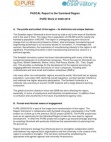Värmland, Sweden
Sweden
There are three regional public organisations in Värmland:
- The County Administrative Board is a government authority and serves as a link for the government, parliament and central authorities to the region and its municipalities;
- The County Council of Värmland has an assembly with elected politicians from Värmland with a mandate to ensure access to healthcare;
- The regional federation, Region Värmland consists of 16 municipalities and the County Council of Värmland. It is governed by 49 elected members.
Since year 2007 Värmland as a whole is part of the Objective 2 program with funding from The European Regional Development Fund (ERDF) and The European Social Fund (ESF). Värmland is also active in the trans-national and interregional ERDF programmes covering the territory of the County of Värmland; the Interreg IIIA Sweden – Norway, Interreg IIIB North Sea Region, Interreg IIIB Baltic Sea Region and Interreg IIIC.
Key characteristics:
- All streams of importance lead to Lake Vänern;
- There are cultivated flat lands around Lake Vänern;
- The province is rich in small lakes, ponds and streams;
- There are several mountain plateaus in the western part of Värmland, which is in the Scandinavian mountain range. The highest elevations are found in the northern parts, with plateaus of 500-700 meters.
- The eastern part of Värmland is counted into the Bergslagen, the Central Swedish Mining
District. Its terrain is rather hilly. This part of Värmland is rich in minerals, most notably iron
ore; - The demographic situation varies within the region. In some municipalities the share of
people older then the age of 65 is over 25 % (the average in Värmland is 19 %); - Värmland covers 19 400 km2;
- Population density is 14 inhabitants/km2;
- Without immigration the population would decrease more rapidly.
Further information:
 Printer-friendly version
Printer-friendly version- 173 reads











